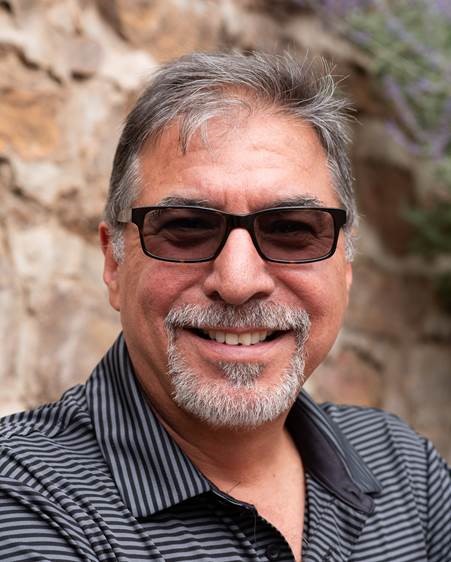In August of 2019, Professor John Nieto-Phillips joined SAR’s board of directors. He has brought to SAR a dedication to opening academic institutions to underrepresented communities and has helped develop anti-bias workshops for faculty who serve on hiring committees, among other accomplishments. As a scholar, Professor Nieto-Phillips explores how ideas about race, language, and culture have shaped the experience of Latinos in the United States and particularly in New Mexico. I recently asked him about his commitment to diversity and inclusion and what these have meant to him in his own life.

I want to thank you for taking the time to talk to me. In addition to serving as a board member at SAR, you’re also a professor and the vice provost for diversity and inclusion at Indiana University, Bloomington. Can you tell me what the words “diversity” and “inclusion” mean to your institution and also to you?
Diversity is foundational to all that we do at the university in terms of research, teaching, and our service to the state and the country. In creating new knowledge, we need different individuals who bring with them different frames of reference. Teaching is about serving a diverse population in the state. Diversity is essential because you want to have different individuals with different kinds of knowledge coming to the table around the study of any given topic, but you also want to prepare students for the world they’re going to enter on leaving the campus. To be able to do that we have to be representative of the complexity of that world. So diversity doesn’t just benefit those students who get access to higher education, it also benefits those students from the majority population who don’t identify as minority scholars and gives them an opportunity to be prepared for the diverse environment in which they’re going to find themselves beyond the campus. That’s part of our core mission as well.
Inclusion is slightly different because it means that people have an equal voice at the table, and this would extend to all populations. It would include those students who are undocumented, who are members of our larger society but who may reside on the margins of the body politic. If we’re truly going to be inclusive, then we have to think about how we can support those individuals at the university and make sure that they not only come to IU but that they excel. So diversity and inclusion go hand in hand, but they’re slightly different.
And what about you personally, why are those things important to you?
You know, I am so lucky to have a PhD. I’m among the first generation in my family to go to college, not because I planned and saved and mapped out my education from an early age, but because in the eleventh grade I went to my mom and said, “Mom, I really want to go to college.” She said, “Mijo, we love you, but I don’t know how to get you to college and we don’t have the money to pay for it, so maybe you have to go to community college or maybe you have to get a scholarship. Why don’t you try to get a track scholarship?” I laughed, and I said, “Mom, you’re kidding,” and she said, “No, just run hard!” I said, “OK, sure,” but I ran hard and I got lucky: I won the state championship for the 800 meters and set a national time for that year.
Suddenly, I had my ticket to college, and from there, my life took another turn. I got interested in history, and I soon learned that the history I learned on my mother’s knee was not the history I was studying. That set me on a journey of questioning and led to research projects in Bernalillo, New Mexico, and Sandia Pueblo. I got a PhD, and I went on to teach at New Mexico State University, which is a Hispanic-serving institution. I loved it, and I got to work with a lot of first-generation students like myself.
I want to do this work not just because I want to include more Latino history in our US history textbooks, but because I want to include more Latino and first-gen students of all backgrounds in our classrooms. I want them to be present and to have life opportunities, not just because of good luck or because they ran fast, but because they have a right to higher education and mentors who can help them adapt to the university and figure out how to pay for it. Part of the reason I took up administration was because I was invited to the table of decision-making, to enable more pathways for more students from more diverse backgrounds. That’s why I do what I do.
You’ve mentioned teaching and learning in a couple of different ways now, and I know that you developed a service-learning class at Indiana. I wonder what you think about the relationship between the education that takes place inside versus outside the classroom and how that relates more broadly to work for social justice?
There’s such an important and often missing link between knowledge and learning in the classroom and the knowledge and learning we all experience in the larger society. I think as an institution of higher learning, we have an obligation to engage with communities around us. I moved from New Mexico State to Indiana in 2004. When I stepped into the classroom for the first time, 80 percent of the students were not Latinx, and I said, “What have I done? I left my congregation back in New Mexico: What is my mission now? What’s my purpose?” And I realized the non-Latinx students who were in my classroom were there because genuinely they wanted to be there. I realized my mission was to spread the gospel of Latino history to everybody.
I had the good fortune of running into the director of service learning and got my students involved in an organization called FLAME (Family Literacy: Aprendiendo, Mejorando, Educando): a group of women, nearly all of whom were undocumented, who would go to a local elementary school in the evening to learn English. Students from my Mexican American history class paired up with the women and asked them to bring in photographs of their lives, narrate those moments in Spanish and English, and create a libro de recuerdos, a memory book. At the end, in one of the most moving moments of my career, a student said, “You know, I was raised to be really concerned about the integrity of our borders and making sure people don’t cross those borders without documentation. I really believed we needed to strengthen the borders and keep people out, but when I got to know this woman and heard her story—if I were in her shoes I would do the same thing.” She went on to be an immigration lawyer. Those experiences are transformative, and service learning helps us to fulfill our mission as educators.
One last question: What do you think an institution like SAR can learn from the stories you’re telling? What can we do to support work for social justice and also to support or educate the various communities that we have: artistic, scholarly, and public?
I think if we go to the core of our mission, which is to better understand what it is to be human, that means engaging with communities. I think we have a very clear sense of responsibility to the communities we serve. Those communities involve people who want to attend our programs and of course they involve our generous donors, but I think we are also responsible for engaging with the diverse communities that produce knowledge, that help us to produce knowledge, and that inform the work that we do, including Native American and Latino communities—the communities around SAR. I think that’s the direction that President Michael Brown is taking SAR. That kind of engagement is key, and I think the kind of programming and outreach that has taken place in the time that I’ve been engaged with SAR, which has been about four years, is an important move in the right direction.
This interview has been edited for length and clarity. Classroom photo by Roel Dierckens on Unsplash.
